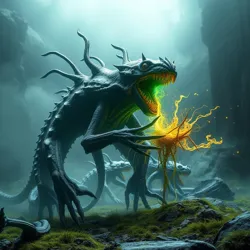Chronovore
A Chronovore is a highly specialized mutant entity capable of perceiving and metabolizing temporal energy. First documented during the Temporal Anomaly Crisis of 2161, these beings have fundamentally altered scientific understanding of both Quantum Biology and temporal mechanics.

Biology
Chronovores possess a unique physiological structure that allows them to detect and consume temporal anomalies. Their bodies contain specialized organs called Time-Processing Nodes, which enable them to digest temporal energy and convert it into usable biological energy. Unlike conventional organisms, Chronovores exist partially out of phase with normal time, allowing them to perceive past, present, and future events simultaneously.
Behavior
These entities demonstrate complex hunting patterns, typically focusing on areas with high concentrations of temporal distortions. They are known to gather in groups called Temporal Pods during feeding cycles, creating spectacular displays of synchronized movement through different time phases.
Feeding Habits
Chronovores primarily sustain themselves by absorbing: - Temporal anomalies - Quantum Wake Disturbances - Residual time dilation effects - Paradox Energy
Impact on Environment
The presence of Chronovores significantly affects their surrounding environment, creating what scientists term Chronological Dead Zones - areas where time flows differently or becomes temporarily suspended. These zones have become subjects of intense study by the Council of Evolutionary Sciences.
Research Applications
The study of Chronovores has led to several breakthrough discoveries in: - Temporal mechanics - Bio-Temporal Engineering - Understanding of causality - Treatment of Time Sickness
See Also
- Temporal Pods
- Time-Processing Nodes
- Quantum Wake Disturbances
- Bio-Temporal Engineering
- Chronological Dead Zones
References
- "The Biology of Time Consumption" - Institute of Temporal Studies
- "Chronovore Impact on Local Time Fields" - Quantum Biology Research Center
- "Social Structures in Temporal Pod Communities" - Journal of Mutant Behaviors